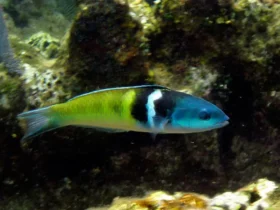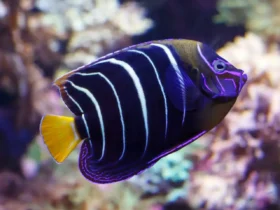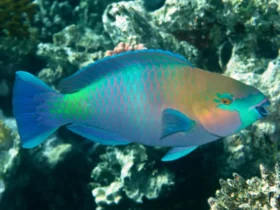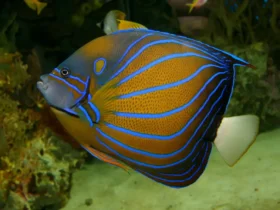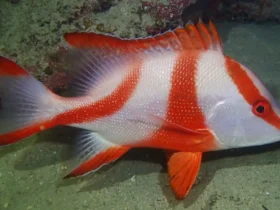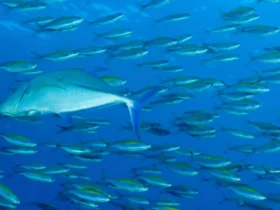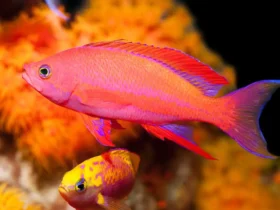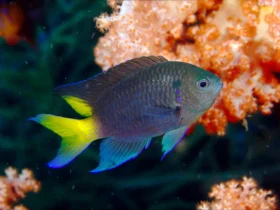Koi fish are incredibly diverse in terms of color and patterns. It can be challenging for beginners to differentiate and remember the names of various Japanese koi varieties. This article will help you easily distinguish different types of Japanese koi.
1. Kohaku
The Kohaku koi fish has two distinctive colors: red and white. The red areas cover 50-70% of the fish’s body surface. Based on differences in color, scale patterns, arrangement of lines, and the number of patterns on the fish’s body, Kohaku koi can be classified into the following varieties:
- Straight Hi Kohaku: This type of koi has a continuous red pattern without interruption from the head to the tail.
- Nidan Kohaku: This variety has two separate red patterns on the body: one from the head to the middle section and another on the rear part of the body.
- Sandan Kohaku: It features three red patterns on the body: one on the head, one in the middle section, and one near the tail.
- Yondan Kohaku: The entire body of the fish has four separate red patterns.
- Godan Kohaku: There are five scattered red patterns on the body, resembling clusters of grapes or cherry blossoms.
- Ginrin Kohaku: The fish has sparkling scales like glitter, with beautiful and vibrant red spots on the body.
- Omoyo Kohaku: The entire body, from the head to the tail, is covered in continuous red without any separation.
- Kanoko Kohaku: The head area of the fish has a relatively dark red pattern, while the body has scattered red spots.
- Tancho Kohaku: The entire body of the fish is white, with a circular red pattern on the head. This variety is highly valued by the Japanese, as it resembles their national flag.
- Inazuma Kohaku: A long red pattern extends from the head to the tail, with the red pattern distributed in a zigzag shape. The lips of the fish are not red.
- Kuchibeni-Kohaku: It has a red dot on the lip (similar to a girl wearing lipstick). The red dot on the lip must be completely separate from the red pattern along the fish’s spine.
- Doitsu Kohaku: The head has a non-circular red mark. The body is silver-white and lacks scales, having smooth skin.
- Menkaburi-Kohaku: The entire head and mouth are covered in solid red. Normally, the red part on the head is separated from the body (or it may be slightly attached).
- Maruten Kohaku: It has a distinct circular red mark on the head, similar to Tancho Kohaku. However, the body of this fish has 3-4 separate or partially attached red patterns. The red mark on the head must not be connected to the red pattern on the body.
These are some of the different varieties of Kohaku koi, each with its own unique characteristics and patterns.
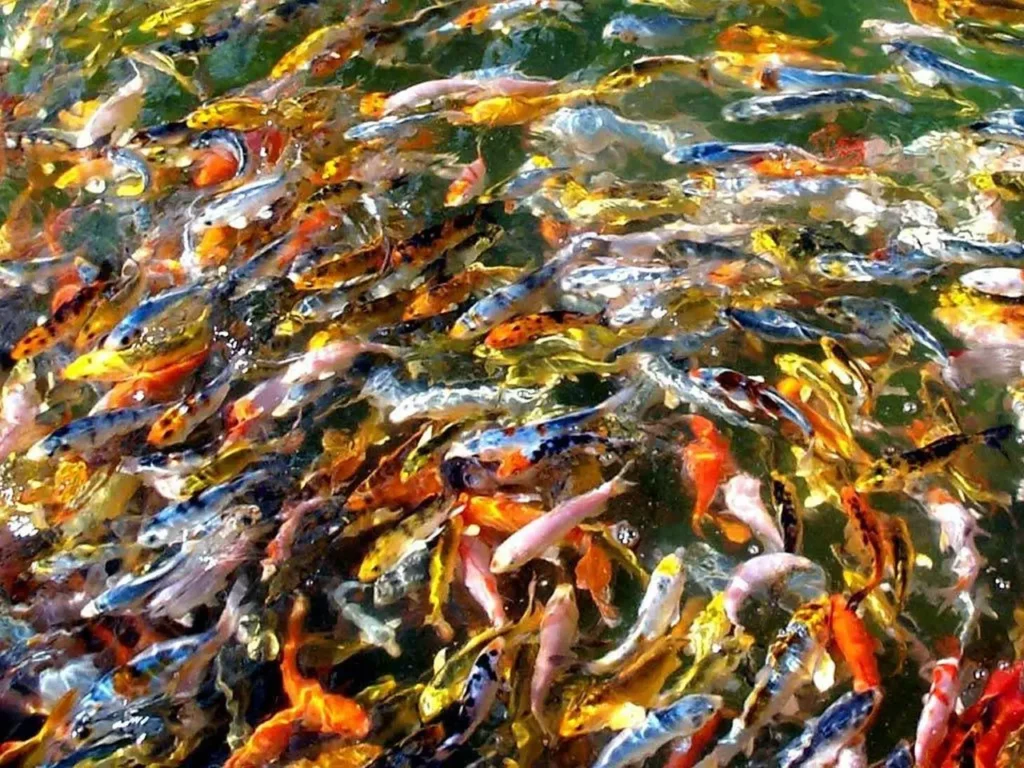
2. Taisho Sanke (Sanke)
Taisho Sanke, also known as Sanke, is a variety of koi fish that originated from the Kohaku (red and white) variety. Sanke koi are developed from the Kohaku koi, with the addition of white scales (Shiroji) interspersed with large red markings (Hi) and small, delicate black spots (Sumi).
As mentioned earlier, Sanke koi are characterized by three main colors. However, depending on the distribution of colors on the body and fins, they can be further categorized into different types:
- Kuchibeni Sanke: This type has a red marking on the mouth. The red, white, and black patterns on the body are intertwined.
- Aka Sanke: The red pattern extends continuously from the head to the tail without interruption.
- Subo Sumi-Sanke: Black spots are surrounded by a white base on the fish’s skin.
- Maruten Sanke: It has a separate red dot on the head, and the body of the fish has three colors: red, black, and white (different from Tancho Sanke, where the body has only black and white colors).
- Doitsu Sanke: The fish has smooth skin and the scales run along the dorsal line.
- Tancho Sanke: It has a round red dot located between the eyes on the head, and the body of the fish has a white base with a few black spots.
- Ginrin Sanke: The fish has shimmering scales resembling glitter.
These are some of the different varieties of Sanke koi, each displaying its own unique combination of colors and patterns.
3. Showa Sanshoku (Showa)
Showa Sanshoku, commonly known as Showa, is another variety of koi fish that originated from the Kohaku variety. However, Showa koi have a larger portion of black coloration (Sumi) on their bodies, especially extending to the head, which is a distinguishing feature from Sanke (which lacks black coloration on the head). The Sumi on Showa koi appears different when observed directly compared to Sanke.
Showa and Sanke are often confused because they both exhibit the three colors: red (Hi), black (Sumi), and white (Shiroji). However, the main difference between these two varieties lies in the base color of the skin. Showa koi have a black base, with white and red patterns on that black base, while Sanke koi have a white base with black and red patterns on that white base.
Here are some key points to differentiate Showa from Sanke:
- Motoguro: A Showa koi must have Motoguro, which are black markings on the pectoral fins and body. It may also have Sumi on other fins. A Sanke koi can also have Teijima (black stripes), but it is not mandatory for Sanke. There are Showa koi with Teijima, and sometimes these stripes can be faint. To have perfect pectoral fins, Sumi on them should cover 30% of the fin’s surface area.
- Head Coloration: Showa koi have Sumi on the head, while Sanke koi do not. The twisting black patterns on the head are known as Hachiware or Menware.
- Sumi Distribution: The arrangement of black Sumi patterns on Showa is different. The black markings are larger and located beneath the lateral line, becoming the background color of the fish. In Sanke koi, the Sumi markings are smaller and scattered above the lateral line.
Similar to Sanke, there are different sub-varieties within Showa as well, including:
- Kindai Showa: Showa with a modern pattern, featuring a balance between Sumi and red markings.
- Ginrin Showa: Showa with shimmering scales (Ginrin) added to the pattern.
- Tancho Showa: Showa with a single round red dot on the head, similar to Tancho Kohaku.
These are some of the sub-varieties of Showa koi, each exhibiting its own unique combination of colors and patterns.
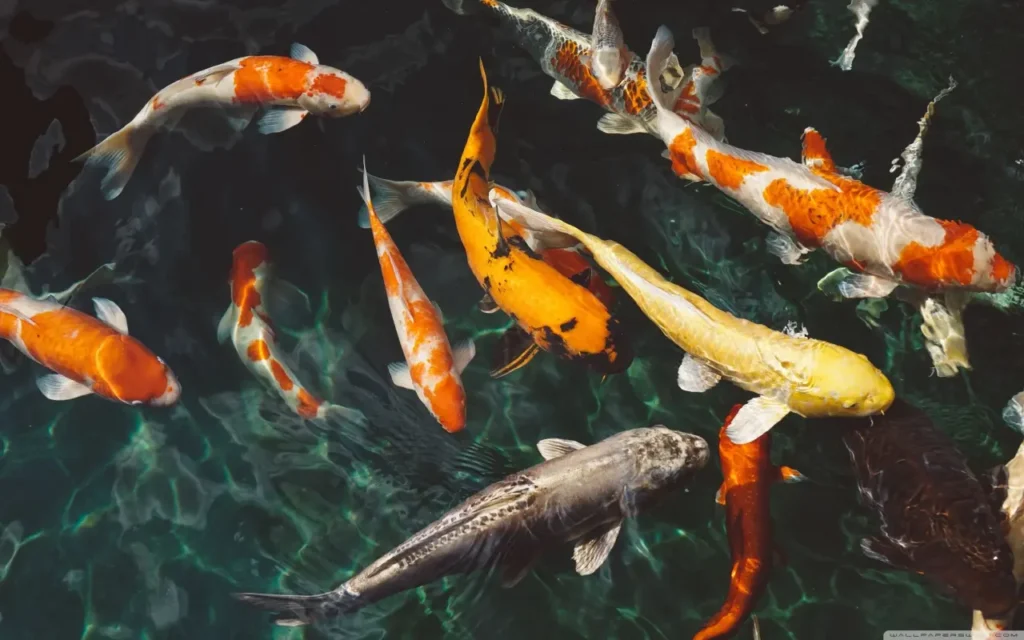
4. Utsuri
Utsuri koi belongs to the Utsurimono group. This variety of koi fish includes three types: Shiro Utsuri (black and white), Hi Utsuri (red and black), and Ki Utsuri (yellow and black).
- Shiro Utsuri: Shiro Utsuri koi have a base color of black with distinct white markings. The contrast between the black and white creates a striking pattern on their bodies.
- Hi Utsuri: Hi Utsuri koi feature a base color of red with black markings. The deep red color combined with the black creates a beautiful contrast and pattern.
- Ki Utsuri: Ki Utsuri koi have a base color of yellow or golden with black markings. The vibrant yellow or golden coloration stands out against the black, creating an eye-catching appearance.
Utsuri koi are known for their bold and dramatic patterns, with the black and contrasting color creating a sense of depth and intensity. The quality of the patterns, the balance of colors, and the intensity of the black markings are essential factors in evaluating Utsuri koi. It’s worth noting that Utsuri koi can also have variations within each type, showcasing different intensities of black, white, red, or yellow, as well as variations in the patterns and distribution of colors on their bodies. Each Utsuri koi is unique and presents its own distinct beauty.
5. Bekko
Koi Bekko belongs to the Bekko group and is known for its simple yet elegant appearance. There are three basic types of Bekko koi, each distinguished by its color pattern: Shiro Bekko (white and black), Aka Bekko (red and black), and Ki Bekko (yellow and black).
- Shiro Bekko: Shiro Bekko koi have a white base color with distinct black markings. The contrast between the white and black creates a clean and classic pattern.
- Aka Bekko: Aka Bekko koi feature a red base color with black markings. The red coloration stands out against the black, creating a bold and striking pattern.
- Ki Bekko: Ki Bekko koi have a yellow base color with black markings. The vibrant yellow color contrasts beautifully with the black, giving the fish a unique and eye-catching appearance.
In terms of appearance, Bekko koi resemble Utsuri koi but with smaller black markings on their bodies and significantly different patterns. Utsuri koi are generally considered more visually appealing and valuable compared to Bekko koi.
While Bekko koi may have a simpler pattern compared to other varieties, they possess their own charm and beauty. The quality of the white, red, or yellow base color, as well as the clarity and intensity of the black markings, are important factors in evaluating the overall quality of Bekko koi. It’s important to appreciate the unique characteristics and individual beauty of each koi variety, as they all contribute to the diverse and captivating world of koi keeping.
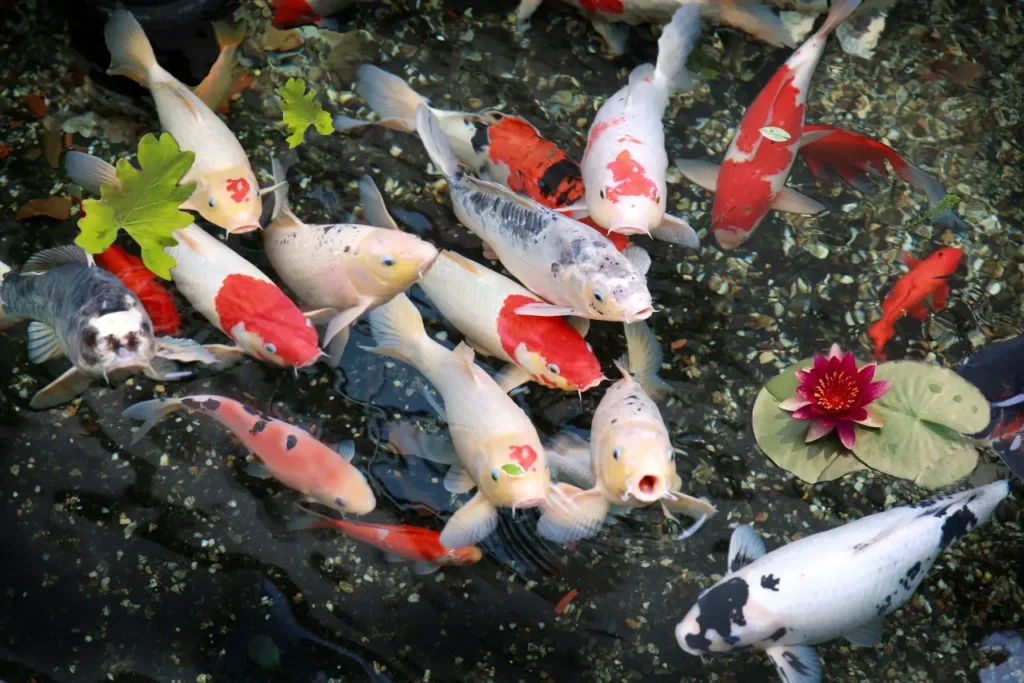
6. Asagi
Asagi is a distinct variety of koi known for its unique and beautiful coloration. The hi (red) markings on an Asagi koi typically have a rust-like appearance. One notable characteristic of Asagi is the absence of hi on the back, which is commonly seen in Kohaku and Sanke varieties. Instead, the back of the fish is covered with scales of a blue-indigo color, with white skin visible between the scales. The belly, cheeks, and base of the pectoral and dorsal fins also display a vibrant red color.
The red coloration appearing at the base of the pectoral fins is referred to as Motoaka, and it is an important feature of a high-quality Asagi koi. Sushui is another variety that shares the same lineage and exhibits similar characteristics to Asagi.
The combination of the blue-indigo scales, white skin, and vibrant red accents creates a striking and elegant appearance in Asagi koi. It is important to note that the intensity and distribution of the colors, as well as the overall balance and symmetry of the pattern, contribute to the aesthetic value of an Asagi koi.
Asagi koi are highly regarded for their unique coloration and are cherished for their tranquil and calming presence in a koi pond. Their distinct beauty adds diversity to the world of koi keeping and is appreciated by enthusiasts worldwide.
7. Shusui
Shusui is a variety of koi that shares similarities with the Doitsu variety, characterized by its smooth, scaleless skin. The distinguishing feature of Shusui is the presence of two symmetrical rows of scales running along its back.
The predominant colors on the body of a Shusui koi are black, white, and red. However, some unique individuals may also exhibit shades of green. The color patterns are arranged symmetrically and create a visually appealing balance. The colors are vivid, with the black scales being a deep shade of green, the red coloration being intense, and the white color appearing pure like snow. The boundaries between the color patches are well-defined, without any blurriness.
The symmetrical arrangement of colors and the clear definition of the color boundaries contribute to the aesthetic appeal of Shusui koi. The combination of the distinct coloration, the smooth skin, and the symmetrical scales along the back creates a striking and harmonious appearance.
Shusui koi are highly valued for their unique color patterns and are admired for their elegance and beauty in ponds and exhibitions. Their graceful presence and the balance of colors make them a sought-after variety among koi enthusiasts.
8. Tancho
Koi Tancho is well-known and easily distinguishable from other koi varieties. Its distinctive feature is the presence of a single round red spot located in the center of its head. Tancho koi are highly regarded by Japanese koi enthusiasts and are considered a symbol of the Japanese flag.
Interestingly, any Japanese koi with a red spot on its head, regardless of its body shape (square, diamond, oval, heart-shaped, diagonal, or flower-shaped), is recognized as a Tancho koi. However, a Tancho koi with a perfectly round red spot is considered the most desirable and highly valued.
There are three main types of Tancho koi: Tancho Kohaku, Tancho Sanke, and Tancho Showa. The common characteristic among these Tancho varieties is the presence of a red spot on the head, while the body patterns resemble those of Kohaku, Sanke, and Showa koi, respectively.
Tancho koi, with their iconic red spot on the head, hold a special place in the hearts of koi enthusiasts. They are regarded as prized specimens and often considered a symbol of beauty and elegance in the world of koi keeping.
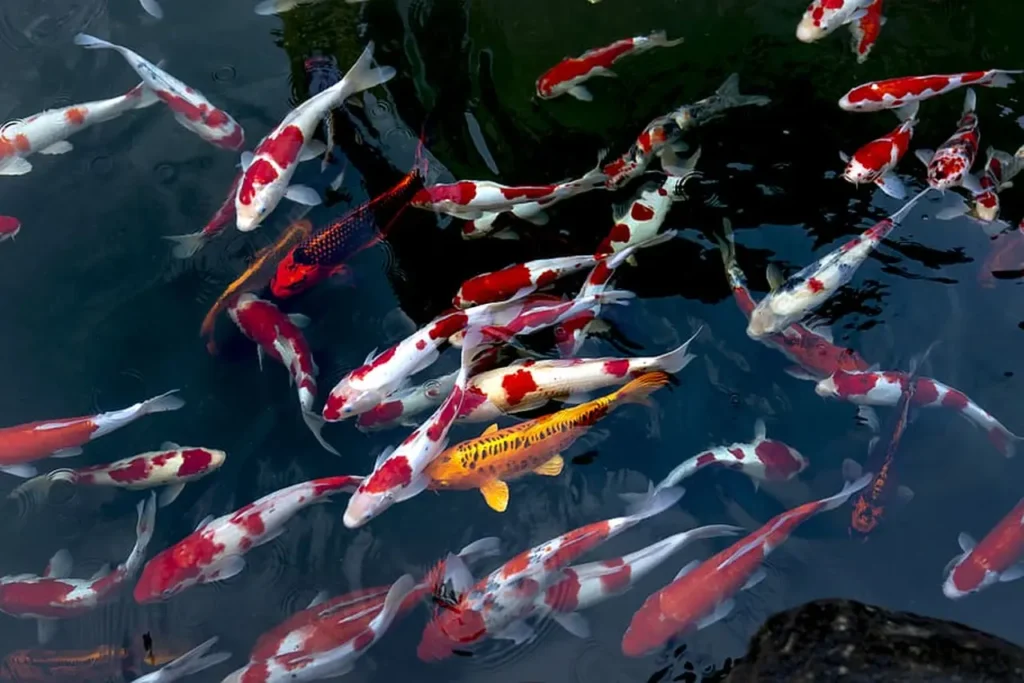
9. Goromo
A koi fish belonging to the Goromo variety must have a pattern similar to that of a Kohaku, Showa, or Sanke koi. The difference lies in the fact that each scale within the Hi (red) color area has a red center and may be surrounded by Ai (indigo blue) or Sumi (black) color.
The beauty of a Goromo koi is evaluated based on certain criteria. The base skin color should be pure white or milky white, without any hint of pale yellow. A Goromo with a clean and unblemished head is highly sought after.
Goromo koi are admired for their unique pattern and coloration. The combination of white, red, and contrasting shades creates an eye-catching and visually appealing appearance. The emphasis on a pure white base color and a well-defined pattern contributes to the overall beauty and desirability of Goromo koi in the world of koi appreciation.
10. Kin/Ginrin
“Kin Gin Rin” is a type of Koi fish that has shimmering scales, also known as metallic or diamond scales. The scales exhibit a bright golden or silver sparkle.
- Kinrin: Scales with a golden sparkle
- Ginrin: Scales with a silver sparkle
11. Goshiki
The combination of Asagi and Kohaku Koi results in Goshiki Koi. Goshiki Koi can be easily recognized by their black-based scales combined with red markings. Goshiki exhibits a more pronounced coloration when raised in colder water environments.
If we remove the Ai (black speckles on the scales) on a white background (Shiroji), we would have a Kohaku Koi.
There are three basic types of Goshiki:
Type 1: It bears many characteristics of Asagi Koi, with indigo (Ai) markings covering the entire body, including the Hi (red) and Shiroji (white) areas. The Hi area is very intense. Type 2: It bears many characteristics of Kohaku Koi, with distinct and intense Hi markings, while the Ai is only present on the Shiroji area. Type 3: It bears many characteristics of Haijiro Koi, with Motoguro (black spots) on the pectoral fins.
When they are small, the shape and coloration of Goshiki Koi may not be very prominent. However, as they grow, they become much more beautiful and vibrant, which is why they are highly appreciated by many enthusiasts.
12. Hikarimuji mono
Hikarimuji mono Koi are similar to Hikarimoyo Koi in terms of their metallic sheen. However, the difference lies in the fact that Hikarimoyo Koi have multiple colors, while Hikarimuji mono Koi have only a single color.
The typical varieties of Hikarimuji Koi include the Ogon Koi, which come in a range of colors such as white, black, yellow, red, orange, and silver-gray. Specifically, they are named Yamabuki Ogon, Platinum Ogon, Orenji Ogon, Mukashi Ogon, Hi Ogon, and Nezu Ogon. Here is a breakdown of the colors and characteristics of each type of Hikarimuji mono Koi:
- Platinum Ogon Koi: It has a bright silver coloration.
- Yamabuki Ogon Koi: It exhibits a vibrant yellow color.
- Orenji Ogon Koi: It displays a rich orange color.
- Hi Ogon Koi: It features a deep red color.
- Mukashi Ogon Koi: It showcases a classic gold color with a slightly duller metallic sheen.
- Nezu Ogon Koi: It has a unique silver-gray coloration.
Each of these Hikarimuji mono Koi varieties possesses its own distinct beauty and appeal, showcasing the elegance of a single color enhanced by the metallic luster.
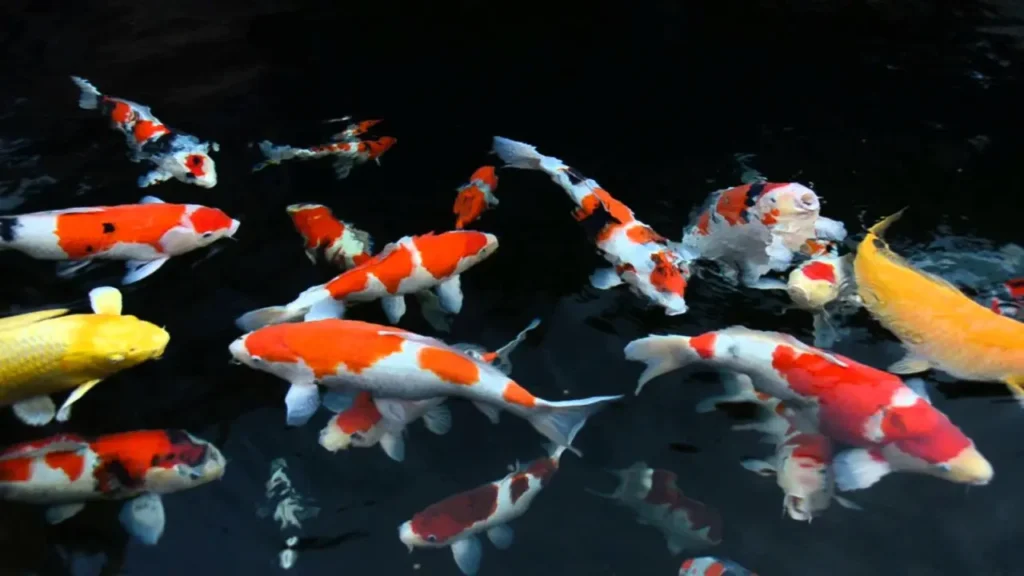
13. Hikarimoyo
Hikarimoyo Koi differ slightly from the Kinrin/Ginrin Koi in that they exhibit a metallic sheen throughout their entire body, whereas Kinrin/Ginrin Koi only reflect the metallic sheen on their scales along the back. In Japanese, “Hikari” means metal or metallic, and the Hikari Utsuri Koi variety also shares this prefix in its name because they are metallic Koi, just like Hikarimoyo Koi.
Hikarimoyo Koi are characterized by their multi-colored patterns combined with a metallic luster. They possess vibrant and striking combinations of colors, often featuring metallic hues of gold, silver, or platinum. These colors are typically displayed on a base of white, black, or red scales, creating a visually appealing and dynamic appearance.
The Hikarimoyo Koi variety includes different subtypes, such as Hikarimoyo (without metallic scales), Hikarimoyo muji (solid metallic color), Hikarimoyo moyo (patterned metallic color), and Hikarimoyo kinrin (metallic scales along the back). Each subtype exhibits its own unique pattern and coloration, resulting in a diverse and captivating range of Hikarimoyo Koi.
Overall, Hikarimoyo Koi are highly prized for their dazzling metallic luster and intricate patterns, adding a touch of brilliance and elegance to any Koi pond or collection.
14. Hikariutsuri
The name “Hikariutsuri” itself confirms that this beautiful variety of Koi is a small branch derived from the Utsuri Koi lineage. The term “Hikari” specifically refers to the metallic sheen, indicating that any Koi variety with “hikari” in its name possesses a layer of luster.
Hikariutsuri Koi can be classified based on the coloration of each Utsuri variety as follows: Hikari Shiro Utsuri, which is the most common with a black and white coloration, followed by Hikari Hi Utsuri, which features red markings and is less common, and finally, Hikari Ki Utsuri, which is the rarest and displays yellow patterns.
Hikari Shiro Utsuri showcases a striking contrast between black and white, creating a bold and dramatic appearance. Hikari Hi Utsuri exhibits a vibrant combination of red and black, making it visually captivating. Hikari Ki Utsuri is characterized by its yellow patterns intermingled with black, resulting in a unique and highly sought-after coloration.
The Hikariutsuri Koi, with their metallic luster and distinct patterns, bring a sense of elegance and charm to any pond or collection. Their rarity and beauty make them prized additions for Koi enthusiasts and collectors.
15. Kawarimono
Kawarimono Koi is a classification that encompasses various hybrid Koi breeds that do not belong to any specific group. It is a collective term used for Koi varieties that fall outside the defined categories. Conveniently, Kawarimono can be divided into three main groups: single-colored Koi, black Koi breeds, and other Kawarimono varieties.
The first group, single-colored Koi, includes breeds such as Benigoi, Shiro Muji, Kigoi, Magoi, Chagoi, Soragoi, and Ochiba Shigure Koi. These Koi varieties feature solid, single colors without distinct patterns or markings.
The second group within Kawarimono is black Koi breeds, which consist of breeds like Karasu, Matsukawabake, and Kumonryu. Black Koi breeds are predominantly black in color and are favored by those who appreciate the elegance of black Koi over vibrant colors.
The third group of Kawarimono includes Koi varieties that do not fit into any specific category. This group includes Matsuba Koi, which feature pinecone-like scales, and Midorigoi, which display a solid green coloration.
Kawarimono Koi offer a diverse range of unique and unconventional patterns and colors. Their individuality and distinctive characteristics make them a popular choice for Koi enthusiasts who seek something different and eye-catching for their ponds.
16. Doitsu Koi
Doitsu Koi are a type of Koi with scaleless skin. They have scales running along their dorsal line and on the sides of their bodies. The Doitsu variety of Koi was created through crossbreeding Japanese Koi with scaleless carp from Germany.
The absence of scales on most of their body gives Doitsu Koi a unique appearance and texture. The remaining scales along the dorsal line and lateral lines can be larger and more pronounced, adding to their distinctive look. Without the intricate patterns and colors of traditional scaled Koi varieties, the focus on Doitsu Koi tends to be on their body shape and overall beauty.
Doitsu Koi come in a wide range of colors and patterns, including popular varieties like Doitsu Kohaku, Doitsu Showa, Doitsu Sanke, and Doitsu Shiro Utsuri, among others. Their smooth skin makes them particularly desirable for those who appreciate their sleek and clean appearance.
Due to their unique characteristics, Doitsu Koi are often prized and sought after by Koi enthusiasts and collectors worldwide.

17. Yamato Nishiki
Yamato Nishiki Koi is a breed of Koi that was developed later on from the Sanke and Platinum Ogon varieties. It can be said that Yamato Nishiki Koi takes the color beauty of Sanke Koi to a new level by adding a layer of shimmering metallic luster to its body.
Therefore, Yamato Nishiki Koi can be classified into various existing Sanke Koi types, such as Kuchibeni Sanke, Aka Sanke, Subo Sumi Sanke, Doitsu Sanke, Maruten Sanke, and Tancho Sanke. The shiny silver coating on the body of Yamato Nishiki Koi is inherited from the solid white-colored Platinum Ogon Koi.
A beautiful Yamato Nishiki Koi must meet the same aesthetic standards as a Sanke Koi. This means that their colors must meet the standards, and the distribution of Shiroji (white base), Hi (red pattern), and Sumi (black pattern) must be well-balanced and harmonious on the body of the fish.
18. Kanoko koi
Kanoko Koi is a type of Koi that has red spots right in the center of each scale. Koi with this type of scale pattern is also very rare.
Differentiating between all the Koi fish can be quite challenging for each individual. With so many colorful varieties of Koi available, it depends on personal preferences or beliefs to choose the most suitable Koi fish. Thank you for following along with the article!
